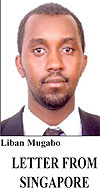I have been following the discussions regarding the traffic proposal in the New Times with much interest but increasing worry; the thrust of the discussion seems to be about making cars cheaper for Rwandans due to the rumoured switch from European “expensive” left-hand drive to “cheap” right-hand drive cars.


I have been following the discussions regarding the traffic proposal in the New Times with much interest but increasing worry; the thrust of the discussion seems to be about making cars cheaper for Rwandans due to the rumoured switch from European "expensive” left-hand drive to "cheap” right-hand drive cars.
We should be wary of the fact that uncontrolled growth in the number of motor vehicles will inevitably result in even greater traffic jams than we are already experiencing.
Instead the discussion should be how to responsibly make transportation more accessible to the population: a range of measures that manages ownership and usage of motor vehicles.
The insatiable appetite for more cars has led to an uphill battle against gridlock in many cities - as a Time Magazine writer put it: "Traffic is like water; it oozes across all available surfaces.”
In fast-growing economies like China, the car population grows at more than 20% per year and peak-hour traffic in mega-cities like Beijing and Shanghai crawls at 5km an hour.
In the United States, motorists spent more than 4.2 billion hours stuck in jams, enough time to fill 65 million iPod Nanos with music, and used up enough extra fuel to fill 58 supertankers.
The "congestion invoice” in the US stands at some $78 billion each year while congestion costs are estimated to be about 1% of GDP in European countries such as Britain and France.
Rwandans likewise desire to own cars and our policies have made it possible for many of them to do so in a record times. And so the vehicle population has grown steadily to a few tens of thousands today. With rising affluence, not only are more Rwandans owning cars, they are also using them more intensively - the number of cars increased by double digits between late nineties and 2010, the number of car trips has undoubtedly more than quadrupled as a result.
The effects are telling. Congestion has increased drastically since the late nineties, with more roads congested during the peak hours.
By observing just how bad the traffic congestion is in our neighbours Kenya and Uganda, we should refrain from adopting any policies aimed at increasing car ownership –because it definitely erodes the competitiveness of a country.
Also, against our ever growing appetite for car use, we are faced with the immutable realities of Rwanda’s situation: a compact country, that is the most densely populated in Africa, with most of it already used up by roads, agricultural, and commercial or residential space.
There are three inescapable solutions from these observations. First, as more and more Rwandans own cars, it is clearly not possible for all of them to drive their cars to and from work every day.
The only way to move large numbers of people efficiently in our densely populated city is by public transport. It is therefore critical that we make public transport much more attractive to the vast majority of Rwandans, including those who have access to cars. That means inexpensive, frequent, and efficient public transportation for the public.
Second, the trade-offs that we are faced with have become much sharper. The more cars Rwandans own, the more extensive and higher the relevant duties/charges would have to be. This is the key trade-off we have to make, to maintain smooth flowing roads.
Third, even with more duties/charges the current vehicle growth rate is not sustainable, given the already large vehicle population and the slowdown in road growth. We have to lower vehicle growth.
These are not easy issues but we have to make these difficult decisions and act decisively to manage car growth and usage to ensure that Rwandans will continue to enjoy a quality living environment. There is always a tension between the individual’s personal interest in wanting unrestrained driving and the social goal of a liveable city.
We must decide whether as people, we are willing to take hard decisions that will benefit our country or whether we will, like many other cities, postpone the necessary, store up the trouble and suffer future gridlock, with the attendant costs to the economy and living environment.
Liban Mugabo is a graduate student


